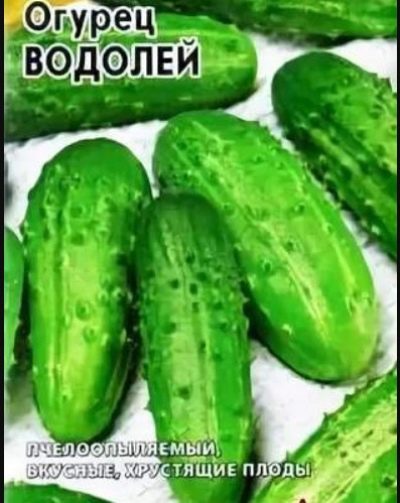
- Authors: V.F. Pivovarov, N.N. Korganova, O. V. Yurina, O.S. Frolova, A.T. Lebedeva, S.A. Aliev (LLC "Agrofirma Poisk")
- Name synonyms: Cucumis Sativus "Vodoley"
- Year of approval: 1989
- Branching: the average
- Fruit weight, g: 108-121
- Fruit length, cm: 12-14
- Ripening terms: early
- Pollination: bee-pollinated
- Fruit shape: elongated oval
- Fruit taste: no bitterness, by 5 points
Bee-pollinated varieties of cucumbers are becoming less and less in demand every year, which cannot be said about Aquarius. Despite such a requirement in cultivation, the crop is capable of producing bountiful yields.
Description of the variety
Aquarius was introduced in 1989 and still easily competes with newer hybrids. The pluses include:
- high productivity;
- early fruiting;
- long periods of harvesting;
- friendly ripening of fruits;
- excellent taste;
- attractive appearance;
- tolerates transportation well;
- the collected seeds can be used for sowing next year.
Despite its significant advantages, the variety also has certain disadvantages:
- bee-pollinated variety;
- reacts negatively to temperature fluctuations.
Characteristics of the appearance of plants and zelents
The plant is of a determinant type, half-stemmed, which determines its limited growth. The maximum length of the main shoot varies from 65 to 100 cm. There are 2–4 first-order scourges.
The branching is medium, the shoots are not very thick, but tough, allowing them to withstand the load and not break. Leaves are pentagonal, medium dissected, green. The leaf plate is rough, slightly corrugated, with rigid veins.
Zelentsy are small, on average 12-14 cm and weighing 108-121 g. Their shape is elongated-oval, with a tuberous surface and a sparse arrangement of tubercles, with white and brown spines. The color of the cucumbers is green. The skin is glossy, thin, but strong.
Purpose and taste of fruits
Possesses pleasant sweet taste without bitterness, characteristic cucumber aroma. When overripe, the fruits do not turn yellow. The flesh of the cucumber is crispy, juicy when cut, without voids, white in color.
Cucumbers are suitable for use both fresh and for canning, pickling, pickling. The skin retains its integrity during heat treatment.
Maturation
Early ripening variety. From the moment the first shoots appear until the beginning of the harvest, 58 days pass. Harvesting begins in early July and continues until the end of August.
Yield
The culture is high-yielding. From 1 sq. m receive from 2.5 to 3 kg of greenery or 222 kg / ha, which is a good result for determinant varieties.
Growing regions
Aquarius can be grown in almost all regions of the country. The variety shows the highest yield indicators in the Central, Volgo-Vyatka, Central Black Earth, North Caucasian and Middle Volga regions.
Growing and care
The manufacturer recommends cultivating the variety by seedling or planting seeds in the ground. The seedling method allows you to harvest 2 weeks earlier.
Seeds are planted for seedlings in late March - early April. Cucumber is a thermophilic culture. Sowing seeds in open ground and planting sprouted seedlings begin in late May - early June, when the threat of frost has completely passed, and the soil warms up to optimal + 12 °.
Before planting, the seeds are soaked, wrapped in a damp cloth, and left in the refrigerator for a day. After that, they are treated with a weak solution of potassium permanganate. The finished planting material is planted in a greenhouse or in separate peat pots.
You need to plant cucumbers in the sunniest area. When carrying out planting work, it is necessary to adhere to the scheme 30X70 cm in the calculation that for 1 sq. m plant no more than 4-5 plants. Zelentsy begin to germinate at a temperature of + 20 ... + 22 °. You need to take care of good ventilation in the greenhouse, the plant does not tolerate air stagnation.
Sprinkle seedlings every evening with a little warm water. After transferring them to a permanent place, you need to monitor the condition of the soil, which should not be waterlogged and overdried. Watering is carried out regularly in the morning and evening. Avoid getting water on the leaves to avoid scalding.
To achieve greater climbing ability, 3-4 lateral shoots are formed from first-order lashes. This will allow the variety not to waste a lot of energy and direct them to the early formation of fruits. The plant is fed 4 times per season:
- after the appearance of 3-4 leaves, they are fed with nitrogen;
- after 3 weeks, the soil is enriched with phosphorus and potassium;
- after another 14 days, compost or rotted humus is added;
- with the onset of fruiting, Aquarius needs ammonium nitrate.
Soil requirements
The maximum yield indicators for the variety when grown on medium loamy air-permeable soils.

In order to collect strong, tasty and beautiful cucumbers on your site, you need to make top dressing. Lack of nutrients can negatively affect the appearance of the plant and significantly reduce the yield. Fertilize cucumbers with organic fertilizers in combination with mineral fertilizers. With the right balance of these components and adherence to the fertilizing schedule, the cucumber yield will be maximum.
Disease and pest resistance
It has good immunity to powdery mildew and downy mildew, root rot and cladosporiosis. But, unfortunately, there is practically no resistance to most of the diseases inherent in culture. For preventive purposes, plants are periodically treated with special preparations or wood ash.

Despite their popularity, cucumbers are often attacked by diseases and pests. From them, cucumber plantings often die before the start of fruiting. In order to prevent this from happening, it is necessary to try to prevent ailments or get rid of them at the very beginning, having studied in detail their causes of occurrence, signs and methods of treatment.





























































































